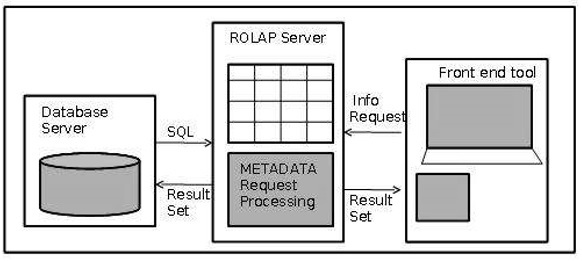
- Data Warehousing Tutorial
- DWH - Home
- DWH - Overview
- DWH - Concepts
- DWH - Terminologies
- DWH - Delivery Process
- DWH - System Processes
- DWH - Architecture
- DWH - OLAP
- DWH - Relational OLAP
- DWH - Multidimensional OLAP
- DWH - Schemas
- DWH - Partitioning Strategy
- DWH - Metadata Concepts
- DWH - Data Marting
- DWH - System Managers
- DWH - Process Managers
- DWH - Security
- DWH - Backup
- DWH - Tuning
- DWH - Testing
- DWH - Future Aspects
- DWH - Interview Questions
- DWH Useful Resources
- DWH - Quick Guide
- DWH - Useful Resources
- DWH - Discussion
Data Warehousing - Relational OLAP
Relational OLAP servers are placed between relational back-end server and client front-end tools. To store and manage the warehouse data, the relational OLAP uses relational or extended-relational DBMS.
ROLAP includes the following −
- Implementation of aggregation navigation logic
- Optimization for each DBMS back-end
- Additional tools and services
Points to Remember
ROLAP servers are highly scalable.
ROLAP tools analyze large volumes of data across multiple dimensions.
ROLAP tools store and analyze highly volatile and changeable data.
Relational OLAP Architecture
ROLAP includes the following components −
- Database server
- ROLAP server
- Front-end tool.

Advantages
- ROLAP servers can be easily used with existing RDBMS.
- Data can be stored efficiently, since no zero facts can be stored.
- ROLAP tools do not use pre-calculated data cubes.
- DSS server of micro-strategy adopts the ROLAP approach.
Disadvantages
Poor query performance.
Some limitations of scalability depending on the technology architecture that is utilized.
Advertisements
To Continue Learning Please Login